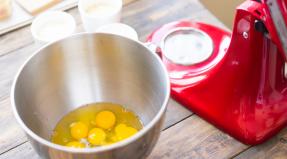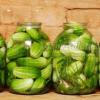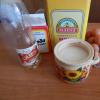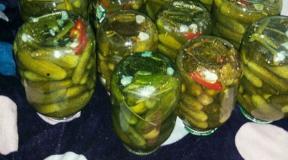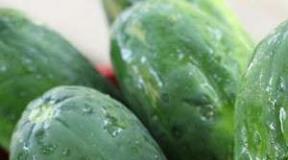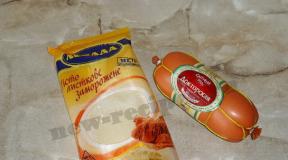Keep bread from mildew longer. How and where to store bread
How to store bread, you should think about even if this product is purchased or prepared every day and eaten during the day. Particular attention to the process of storing bakery products should be paid to those housewives whose food does not get stale with time, but are covered with mold. A few years ago, people did not even encounter such a problem simply because plastic bags were not so common and accessible. Today, you can use several ways to store the product: in the refrigerator, breadbasket, paper or cloth. Each approach has its positive aspects and nuances.

Features of the breadbox
On the one hand, there is nothing easier than the use of bread bins for the storage of bakery products. Unfortunately, in practice, many people forget about the important nuances of this approach:
- In the container, the bread is laid out only in the cooled form, and it must be taken out of the package in which it was sold.
- If the device is not tight or too often opened by family members, the loaf can be additionally wrapped in paper. This will protect her from the negative effects of fresh air.
Tip: Despite the fact that today bread-boxes made of food-grade plastic, impact-resistant glass and even ceramics are actively offered, wooden products remain the best option. They actively absorb excess moisture emanating from fresh bakery products, so they do not lose and do not sour. The main thing is not to forget from time to time to dry the structure.

- Products with opposite composition should not be kept in one breadbasket, especially if they have pronounced odors. If everyone in the family loves different bread, you should pay attention to bread bins, divided into compartments.
- At least once a week, the device should be freed from bakery products, swept out all the crumbs from it, and ventilated for half an hour. If an unpleasant smell began to emanate from the material, wipe it with a very weak solution of vinegar (no more than a tablespoon of the reagent per glass of water) and dry it in fresh air.
If it so happens that there is no bread box on the farm, for a while it can be replaced with a conventional stainless steel saucepan. The lid should fit snugly to the product; you should not use it for cooking at this time.
- For storing bakery products in the cold using paper or cellophane. We take only this product on the basis of natural fibers of viscose, and not its synthetic analog!
- Regardless of the form in which the component is stored in the refrigerator, in a few hours it will begin to actively release moisture. Therefore, with this approach, bread should be eaten within 2-3 days. After this time, although it does not deteriorate, it becomes dense and taut, losing its taste.
- If storing bread turns into torture because the product is consumed very slowly and often has to be thrown away, you can try the freezer option. In this case, from the selected bakery products, we make slicing; we wrap each slice in cling film and put it in the freezer. If necessary, get a slice, defrost it at room temperature and gently heat it in the oven.

Do not try to first keep the bread in the refrigerator, and then - in the bread box. This, although it will slightly increase its shelf life, will negatively affect the texture and taste data of the product.
Some more ways to store bread
If for some reason the options with the storage of bread in the refrigerator or breadbasket do not fit, it is worth considering a little less popular, but rather effective options:
- In paper bags. We wait until the roll cools down, then we put it in a clean paper bag and wrap it tightly. The product is removed in a cool place, away from sunlight. Fresh air circulation is welcome. If done correctly, the product will remain fresh for 4-5 days without changing the texture. The package can be replaced with the most ordinary writing paper without inscriptions.

- In a linen cloth or canvas bag. The approach differs from the previous one only in that the loaf is wrapped in fabric. If a new paper is used each time, the fabric needs only to be ventilated and washed from time to time.

Applying such approaches, we must understand that in one section of a cloth or a paper bag one cannot spread several types of bakery products or even loaves of the same bread. All products must be supplied in individual packages.
To obtain the maximum positive result should adopt a few secrets. They will help not only to extend the shelf life of products, but also to preserve their texture, reanimate dried products:

- If you put a cut apple or potato in the bread box next to the loaf, the product will stay soft longer. Just do not forget to update the slice of the auxiliary component.
- Bread correctly cut not from the edge, but from the central part. Then the halves can be folded, retaining their freshness.
- Another hot loaf, for example, baked at home, should definitely be cooled before cleaning. You should not try to keep it warm for a long time, it will only spoil the product.
- If the slices of bread become stale, sprinkle them with water and hold in a warm oven for 2-3 minutes. True, there is a need for such a product until it has cooled.
- Another way to restore the bread's softness is to use steam. For this, a steamer or a usual colander located above boiling water is suitable.
Bakery products cooked at home are stored the longest. Only they should add a little vegetable oil, and the yeast should be completely eliminated or used to a minimum.
Bread at home should always be. Guided by this rule, people sometimes buy more loaves and rolls than they need. What to do with the "main product", which was unclaimed? Throwing his hand does not rise.
There are two ways to solve the problem. Learn to store bread and bakery products so that they remain fresh for a long time. And if you still become hardened - also put into action.
Bread box - the traditional way of storage
So, how to store bread? Much depends on what kind of varieties you prefer:
- Someone takes the loaves in the store - they are often already cut and packed in plastic.
- Others buy pastries at kiosks - while hot.
- Still others bought a bread maker and baked at home.
But there are general rules for storing bread at home, which should be followed.
For bakery products, you must create special conditions. Many housewives purchased bread bins - from plastic, metal, wood. If you do not know what to give to friends, such a thing will be a good gift.
- Plastic bread box is lightweight, inexpensive, convenient to wash. However, it is short-lived.
- Metallic will serve you for many years. It is also convenient to care for her.
- But the best option is wood. Where can I buy one? Most often in the market, the masters.
Here is the only "but." After you wash the wooden bread box, dry it so that it does not dampen.
Mistress note
Instead of washing a wooden breadbasket, you can apply flooding (burning). Soak a cotton swab in ethyl (medical) alcohol and light a cotton wool directly in the bread box, covering the lid. Fire - the enemy of fungi and bacteria.

Especially long loaves will be stored in the breadbasket made from juniper
Why does bread grow moldy in a breadbasket?
Most likely, the baking raw materials were of poor quality and already contained mold spores. Once in a favorable environment in your kitchen, where it is warm and humid, these spores have grown in "violent color." Or the mold remained in the bread box after you threw out the previous spoiled loaf from it.
- If mold occurs regularly, air more often the room where the breadbasket stands and wash it every time before putting in a fresh loaf.
- If the bread of the same sort from a certain producer grows mold, simply refuse to buy it.
Secrets of long storage
- Before storing it, wrap the loaf in a clean cloth or plastic bag, pre-puncture holes in it. The air must have free access to the loaf, otherwise mold will appear.
- If you store baked goods in large pots, under the lids, also wrap them in cotton cloth or put them in a bag.
- Wash the cotton napkin or towel, in which you wrap the flour products, with soap or other detergent without fragrance. You don't want buns to smell like laundry detergent?
- Hardware stores often sell special bags. They have three layers. The outer and inner is the fabric, and in the middle is a layer of plastic. When stored in such a bag, bread can remain soft for 4-5 days.
- The bag can be sewn independently, and then soaked to a strong solution (2 tbsp. Spoons per liter) and, without rinsing, dry.

Special bag - alternative storage
Little tricks
If you put a piece or a handful of salt wrapped in cheesecloth in a breadbasket or pan, bread will remain fresh longer.
Storage location - refrigerator
How to keep bread in the fridge, and can it be done at all? You can, but again you need to know the rules.
If you want to keep bakery products for a long time, cut them into slices, pack in plastic and put in the freezer. Then you can get a few pieces when needed. At room temperature, they quickly become soft.
The rules for keeping bread in the refrigerator depend on where you put it:
- In the freezer, bread can be stored for several months.
- If you put it on the top shelf of the refrigerator, the period will be reduced to 2-3 days. And then, if the bakery products will be packed in plastic.
The temperature in the chamber ranges from 0-5 ° C. It is under these conditions that the shelf life is reduced and flour products harden the fastest. That is why it is believed that you can not store bread in the refrigerator. Mold in the refrigerator bread will not, even if the raw material contains a fungus.
Council of the day
Starting to use a loaf, cut it in half. And further cut the slices from the middle. Removing the remaining bread for storage, press the slices of the two halves to each other. Then the inside of the loaf will not blacken any longer.
Black and white - together or apart?
Now let's talk about varieties. Black and white bread should be stored separately from each other:
- First, they have different humidity.
- Secondly, the "noggin" has a stronger smell, which will definitely go to white buns if they lie together.

The opinion that black bread is healthier than white is not true. It all depends on the individual reaction of the body to a particular variety.
Loaves and "sliced", bought in the store - this is a bread of long-term storage due to special additives. If you prefer to taste hot baking produced by a local plant or you bake it yourself - do not put the loaf in a plastic bag until it finally cools. Moisture that will be released during the cooling process will cause the carpet to become moldy.
Homemade bread, subject to the rules of storage, will be used for 8-10 days.
Do you know that…
If a piece of bread began to deteriorate, moldy - you can not let this matter run free. It should be immediately discarded so that it does not “infect” other flour products.
Second life loaf
What to do if the bread is still stale:
- “Second Life” can be inhaled into it by slightly moistening it with water and holding it in the oven for 1-2 minutes at a temperature of 40-50 ° C.
- You can moisten a stale loaf of sweetened water with vanilla, after the microwave will eat a pleasant, fresh baking.
- You can also use the "water bath". Pour some water into a large saucepan and put it on the fire. Place the bread in a colander so that it is enveloped in wet steam, cover with a lid. In a few minutes the loaf will be soft. The taste of fresh pastries will not return, but it will turn out quite edible.

Dried bread in a number of diseases of the gastrointestinal tract is preferable to fresh. It is also useful for dieters.
We answer the question: why bread is fast growing?
Protein products added to can delay the crystallization process:
- high protein;
- broth handful of crackers - here you have and croutons. Such crackers can be thrown on the pan to the fried eggs.
In the culinary literature you will find many descriptions of dishes using stale bread - ranging from casseroles and ending with desserts. There are videos dedicated to this topic:
Now you know the secrets of saving bread and bakery products, how to keep them in the refrigerator, and that bread can be frozen. But still this product is intended for quick use. So try to buy bread in moderation.
Keep it right and be healthy!
Read the article? Please give feedback:
- Rate the article and share with friends on social networks if it was useful and you learned something new.
- Add material by writing a comment if you have your own experience in storage or disagree with something.
- Ask a question to our specialist by clicking the button below and get a qualified answer if you did not find it in the text.
Thank you in advance! It is important for us to understand that we are not working in vain.
Bread is a special product. According to our ancestors, a house in which the aroma of fresh pastries is not worth it is considered poor in every sense of the word. Today, very few people bake bread at home. Mostly fresh crispy bread bought in small bakeries and large supermarkets. How and where to properly store bread, so that it remains tasty and healthy for as long as possible?

In the bread box
One of the most popular baking containers is the bread bin. Today, manufacturers of kitchen utensils offer us the widest range of different materials. So, the most common are breadbaskets made of wood, metal and plastic.
The wooden bread box will provide the necessary level of humidity and a sufficient amount of incoming oxygen, which will save the bread from stoning and mold. Experts recommend to pay attention to products made of birch, lime or ash. From those that are made of coniferous wood, it is better to refuse: a sharp smell of pine needles can interrupt the flavor of bread.
Breadbaskets made of metal are more practical in everyday life from a hygienic point of view. They are much easier to wash. When choosing a metal breadbasket, it is very important to carefully inspect the product: it must have holes for ventilation, non-slip rubberized legs and a noiselessly closing and opening lid.
Plastic breadboxes are affordable, easy to care for, and their range is incredibly wide. But it is important to choose the right capacity. Before you buy, be sure to smell plastic - cheap material will let you know about yourself with a strong and strong chemical smell. It is better not to buy such a breadbasket, as low-quality plastic can affect the composition of the bread, and it, in turn, affects your health.
In a refrigerator
The question of storing bread in the refrigerator must be approached very carefully. This is due to the fact that baking has a number of features that must be considered. So, it is important to remember that bread absorbs extraneous odors. Therefore, it should not be stored near fish, cheese or any other strongly smelling product. There is also yeast in bread, which, in contact with food, can spoil their taste.
If you bought or baked too much bread, the most reasonable option would be to freeze it, and pre-cut it into portions.
There is a number of limitations in storing bread in the fridge. Do not put in the refrigerator spoiled loaf, as the fungus can easily infect other products. It is not necessary to wrap the bread in a bag without air access; there must be small holes in the package for ventilation. In no case should you put a warm or hotter loaf in the fridge. Here we are talking about the safety of the compressor, which can deteriorate due to a sharp increase in power consumption.
If you bought or baked too much bread, the most reasonable option would be to freeze it, and pre-cut it into portions. At subzero temperature, it remains valid for several months. You can defrost it in the microwave or oven. After defrosting, bread should be eaten within 2 hours.
In fabric and polyethylene
Our grandmothers and great-grandmothers preferred to store bread in canvas or linen bags. The fabric will save the taste and quality properties of bread during the week. Today, many choose ordinary plastic bags as their “clothes” for storing bread. In this case, it is very important to make holes in them for air circulation - this will save the bread from the danger of mold.
In the hardware stores, you can search for special bags for storing bakery products. They consist of three layers - cotton, perforated polyethylene and again cotton. Such bags very successfully combine old, time-tested traditions and modern developments.
Secrets of refreshing stale bread
If the bread still began to grow stale, do not rush to send it to the trash. There are several ways to help you quickly reanimate the product at home:
- Sprinkle bread with clean water and send it to the oven heated to 150 ° C for about 5 minutes.
- Cut stale bread into pieces, put them in a gauze bag or colander. Hold the bread over boiling water for a couple of minutes.
- It is very easy to make croutons from stale bread. You can dry them in the oven or fry in a pan over low heat. Crackers will be an ideal addition to broths and cream soups, as well as an excellent breading for fried dishes.
Wherever you decide to store bread, remember that this product needs certain conditions. Do not put it next to a strong-smelling food, do not keep it in tightly closed bags and do not use low-quality bread loaves. But most importantly - buy exactly as much bread as you really need, and not in reserve.
For a long time in Russia they were very careful about bread. Freshly baked bread was wrapped in a linen towel to keep it fresh longer. And today there are more effective ways to do this.
Why bread grows stale?
To get started is to understand the reasons why fresh and soft bread becomes stale.
One of the reasons is the retrohydration of starch (crystallization). During storage, the starch that is contained in the bread begins to lose moisture and the bread becomes hard, as well as its taste and weight. You can stop this process by freezing.
If bread is stored in the refrigerator, it will also lead to staling. But the mold will not appear for a long time.
It has been observed that whole-grain bakery products remain soft longer.

How to keep bread in order to preserve its freshness longer
- after removing the bread from its original packaging, put it in a clean, dry, ventilated container;
- do not store bread in the sun or in the cold, it is better to store it at room temperature;
- breadbaskets are best used clay or wood, which has ventilation;
- before putting bread in the breadbasket, it is best to wrap it in baking paper;
- wipe regularly with vinegar to avoid mold growth.
- if you put a ripe apple on the bread, it will stay fresh longer;
- rye bread should be stored separately from the white;
- so that the bread does not mold, it should be placed in a bread box with a cotton swab dipped in iodine.
Sometimes they say: "there is even no bread," implying that this product should always be in every home. And preferably fresh. How to store bread so that it does not grow stale, moldy and retain its flavor?
Method number 1 storage of bread
In the old days, it was customary to wrap bread in a linen or linen towel, preferably monophonic, and in especially solemn occasions - with a small embroidery. Our ancestors also found that if the bread is wrapped in clean white paper or cloth, then drying will slow down and the loaf will retain its properties for up to 7 days.
Method number 2 storage of bread
It turns out that bread grows fastest at a temperature of + 2 ° C - namely, so much on the top shelf of the refrigerator. The fact is that fresh bread has a certain moisture content (about 50% on average), and as a result of storage the moisture evaporates from it and the bread grows stale. And the process of evaporation of moisture from the bread is most intense at a temperature of 0-2 ° С. Therefore, it is better to store bread at room temperature or in the freezer, but not in the refrigerator.
Method number 3 storage of bread
Today, many keep their bread in plastic bags. But experts notice that they are not desirable to reuse! Bread is stored even better in plastic bags with holes. This allows it to stale and prevents the appearance of mold within 4-5 days. Holes can be made a hole punch.
Method number 4 storage of bread
Another modern option is special bags, which are sold in supermarkets and household departments of stores. They consist of three layers: the top and the lining of cotton fabric, and between them - a layer of perforated polyethylene. Such bags allow you to preserve the beneficial substances of bread and its freshness for a very long time.
Method number 5 storage of bread
In order to keep the bread fresh for a long time, there is such an old way: cutting a whole loaf or loaf of bread is necessary not from the edge, but from the middle. Dividing the loaf in half, cut from the middle of the desired number of slices, and the remaining parts tightly fold the cuts to each other and store. Thus, the bread remains as if protected from two sides and does not get stale longer.
Method number 6 storage of bread
In the freezer. Georgy Dubtsov, Ph.D., professor, head. Department of Catering Technology, Moscow State University of Food Production: According to modern baking technology all over the world, bakeries produce under-baked products: in this form, it can be stored in the refrigerator for quite a long time. And we have many chain stores and snack bars bake bread, deliberately shortening it a bit. It is stored as a semi-finished product, and then immediately before selling it is baked completely. This principle can be used at home. In the freezer at a temperature of -18 ° C, bread can be stored for up to six months. And you can freeze any kind of bread: black, and white, and grain. Before use, it should be heated at a low temperature in the oven. However, keep in mind that after defrosting the bread hardens very quickly, so it needs to be reheated just before use.
Method number 7 storage of bread
But baking will retain its freshness for 2-3 days, if you put a raw apple in the pan with it.
Method №8 storage of bread
Bread does not harden so quickly, if you put a piece of sugar, a small peeled potato or an apple slice into the bread box - this will remove excess moisture and maintain the level of humidity at the same level.
Method №9 storage of bread
If you have baked your own bread, you must be completely cooled for three hours before removing it for storage. Chilled bread is better cut and does not crumple under the knife.
Cool the bread on a wire rack, removing from the mold and hiding from drafts.
Method number 10 storage of bread
Black and white bread can not be stored together, since the mixture of bread yeast leads to its deterioration: the bread begins to mold. In addition, white bread in this case acquires a peculiar smell of black. Therefore, lay out different types of bread in paper or plastic bags.
Method number 11 storage of bread
Protect bread from mold handful of salt, placed in a tightly closed breadbasket.
Method number 12 storage of bread
It is best to keep the bread in a sealed container. You can choose to store special bread bins - for example, metal, plastic, wood. Such containers should be sufficiently airtight and have a minimum area of ventilation holes, and they should also be in a dry, bright place so that there is no mold that quickly forms in the shade.
Method №13 storage of bread
Bread is kept well wrapped in a linen napkin in wooden bread boxes. The best of them are from juniper and bark. But finding a juniper breadbasin is not easy, and it is not cheap, although simpler options are possible with different types of wood, including in combination with juniper. In the bread boxes of birch bark, mold and fungus do not appear, as bark is an excellent antiseptic.
Method №14 storage of bread
So that the product does not spoil directly in the bread box, you need to periodically wash and wipe it with vinegar and dry well. Remove crumbs at least once a week.
Method №15 storage of bread
Do not buy extra bread.
How can you refresh stale bread. Fresh recipes
If the bread is still stale, in no case do not throw it away! There are ways to make it not only useful, but also very tasty.
Cut into thin slices, dry and serve to the table in the form of crackers. Store them in clean linen bags. Crackers can also be used for breading, cooking jelly, casseroles, kvass, or eating with broth.
If a loaf of bread or a loaf of stale bread is sprinkled with water and placed in the oven for 3-5 minutes at a temperature of 150-160 ° C, then the bread again becomes fresh.
Another way to refresh stale bread is to place a smaller pan on a stand in a large saucepan with water. Put bread in it, cover and hold over low heat until the smell of fresh bread appears.
If a whole loaf has become stale, it is necessary to cut it into pieces no more than one centimeter thick. Sliced pieces should be put in a colander or a sieve, you can tie it in a gauze bag, and arrange over boiling water at a height of 2-3 cm.
Hot bread does not lose its freshness for a long time if it is put in a thermos with a wide neck. Similarly, you can "reanimate" stale cookies, buns and any dough products.
In addition, bread - cheese - egg casseroles can be made from hard bread. It is made according to the following recipe: cut the bread into small cubes. Mix butter, eggs, salt and pepper. Beat the mixture with a mixer or manually. Grease the form with oil. Put the crackers, pour the resulting egg mixture and wait 20 minutes until soaked. Sprinkle any grated cheese on top and put in the oven for 20-25 minutes.
Enjoy your meal!

